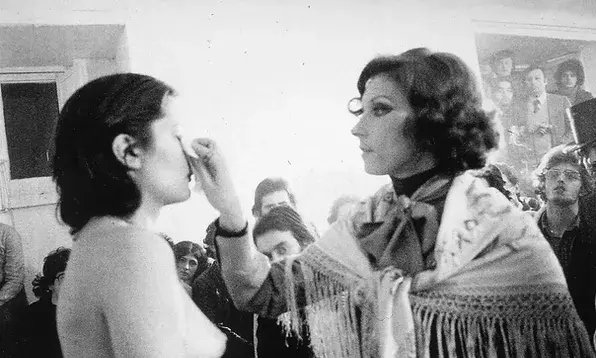
Feminism in Art
RHYTHM 0
Isabella Krieg
Performance art is described as a "time-based art form that typically features a live presentation to an audience or onlookers... and draws on art such as acting, poetry, music, dance, and painting." (Britannica). In the 60s and 70s, performance art was characterized by improvisation and spontaneity, audience interaction, and political agitation. It was meant to challenge traditional art conventions as a way to find a new audience or test new ideas. It soon became a favorite art form for feminist artists, one example being Serbian artist Marina Abramovic. In 1974, Abramovic created a group of performances as a part of her Rhythm series, in which she explored themes such as "control, the loss of it, and the limits of the human body." (Graf). Rhythm 0 was the last piece in her series, seen as the most dangerous one.
The performance took place in 1974. Abramovic gave her audience the
following instructions:
There are 72 objects on the table that one can use on me as desired
Performance:
I am the object.
During this period I take full responsibility.
The performance was set to go on for six hours, in which Abramovic gave
the audience full control over her body and the objects on the table.
Amongst the 72 objects was arose, polaroid camera, newspaper, red paint,
a book, scissors, a kitchen knife, a gun, and a bullet. Abramovic gave the
audience the opportunity and choice to use the objects in a way that was
either pleasurable or harmful to her, and intended to question the
responsibility of whoever participated. The piece started off tame. Art
critic Thomas McEvilley describes the events that took place, writing that "Someone turned her around. Another person thrust her arm into the air. Someone else touched her somewhat intimately," Although its arguable whether being touched intimately could be considered tame or not, the events that followed became worse. Within an hour, all her clothes were cut off and she was sexually assaulted. McEvilley went on to write how "When a loaded gun was thrust to Marina's head and her own finger was being worked around the trigger, a fight broke out between the audience fractions." Not every audience member participated in the violent, but not everyone intervened when someone else went too far. Although it's not clear if the performance ended because the 6 hours were over of because the audience eventually put a stop to it, we do know that the audience fled out of fear of facing Abramovic. The piece questioned morality, as audience members did things they wouldn't normally do in real life. They were put in the uncomfortable position of deciding whether someone lives or dies, and the fact that the audience fled after the performance shows they realized their actions were morally wrong, even if they participated or failed to intervene. However, the audience might have felt encouraged to commit acts of violence after hearing the initial instructions, and seeing the suggestive items on the table, indicating the ability for violence. After the performance, Abramovic says part of her hair had turned completely white, and she was covered with scars and the feeling of fear for a long time.
Abramovic herself stated she never thought of Rhythm 0 as a feminist piece, but these ideas show through her performance. Despite the fact that performance art was already seen as "attention-seeking, sensationalist, masochistic, and exhibitionistic," (Graf), Abramovic being a woman gives the piece a bigger impact. Women in the art world during the 70s were already prone to censorship. In the performance itself, Abramovic reduces her status to an object, allowing the audience to decide what they want to do with her. It shows a female body going through violence and sexual assault, a body being used and objectified. A Serbian publication had written that Abramovic "wasn't too bad to look at" and that "someone might be able to use her." Abramovic herself stated she "never thought that it was female energy that drove the piece and that the courage to do this piece seemed more male from her point of view." (Graf). Regardless of what her initial intentions were regarding the message of the piece, we can still see feminist questions being asked. Would the performance have gone differently if Abramovic was a man? And how might the audience have acted if no one else was watching?

Abramovic

Abramovic positioned to point a gun to her head
More from Rhythm 0








.png)